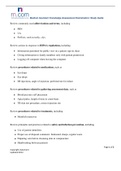Lipid oxidation (L2 + L3)
Lipid oxidation can lead to:
- Decrease of nutritional value
- Color changes
- Texture changes
- Off-flavors
➔ Decreased shelf-life
1. Lipid oxidation: general mechanisms and flavor consequences
Food lipids
- Compounds of biological origin, soluble in organic solvents and insoluble in water
(not very clear definition)
o This definition does not fit with very short chain fatty acids (FA), that are also
soluble in water
Physical state:
- Oil = liquid at room temperature
- Fat = solid at room temperature
Polarity/solubility:
- Non-polar lipids → triacylglycerols (95%)
- Polar lipids → phospholipids
o 2 fatty acids instead of 3
o On the 3th group there is a phosphor-group → makes the molecule
amphiphilic → can be used as emulsifiers in food products
o Also have the glycerol backbone
Fats and oils might contain some amounts of impurities (e.g., water, proteins, metals, etc.)
that could be removed during refining steps.
1
,Lipid functions:
- Biological/physiological
o Structural role: cell membranes are constituted from phospholipids
o Functional role: precursors of hormones, liposoluble vitamins, anti- and/or
pro-inflammatory molecules (e.g. prostaglandins)
o Energy storage: triglycerides can be stored in the adipose tissue of animals as
an energy reserve
- In foods
o Texture, mouthfeel and melting properties: creaminess, viscosity, etc.
o Surface-active properties to influence structure of foods
o Flavor: both positive (specific flavor in dried foods) and negative (off-flavors
caused by oxidation)
o Nutritional value: caloric density, essential fatty acids, vitamins, etc.
o Technological role: e.g., frying oil
Funfact: lipids constitute 50% of brain dry weight, where they have important structural
(isolation of nerves, cell membranes, etc.) and signaling functions.
Fatty acids
- Fatty acids:
o Hydrocarbon molecule with a carboxyl terminal
o Mostly even numbers of carbons with a carbon chain between 10 and 22
carbons
o Sometimes are free, but mostly esterified
- Saturated fatty acids = no double bonds
- Unsaturated fatty acids = at least 1 double bond
o Double bond usually in cis configuration; may change to trans upon
hydrogenation which is sterically more favorable, but are cis because they are
produced via an enzymatic pathway
o Monosaturated fatty acid: 1 double bond
o Polyunsaturated fatty acid: 2 or more double bonds. methylene interrupted
(1,4-pentadiene): so a structure over 5 carbons with 2 double bonds →
Double-single-single-double
Notation of fatty saturated fatty acids:
- Systematic name determined by the chemical structure
- Common name, most commonly used
- Short notation:
2
,Fatty acid profiles are dependent on the food source:
- Milk: shorter chain fatty acids
- Vegetable oils: enriched in C18 fatty acids
- Fish oil: high concentration in EPA and DHA, two highly unsaturated 3 fatty acids
Lipid oxidation
Hydrolysis:
- Triglyceride is broken down into three fatty acids and a glycerol
- Occurs in the presence of water and can be catalyzed by alkali, acids and enzymes
(e.g., lipases)
- Partial hydrolysis can yield in monoglycerides (one FA esterified on glycerol
backbone) and diglycerides (two FAs esterified on glycerol backbone)
- Can stimulate oxidation as free FAs are more sensitive to oxidation compared to
esterified FAs, however it can still happen for esterified FAs
General scheme for lipid oxidation:
first upper arrow
the entire circle
two red arrows that
move away from circle
LH means that the lipids have all their H-atoms, L* is without H-atoms
Red arrows mean that the reaction is catalyzed
3
, 3 main steps:
- Initiation: light, metals or ROS catalyze the formation of an alkyl radical (L*) by
hydrogen abstraction from an unsaturated fatty acid (LH)
- Propagation: alkyl radical reacts very quickly with oxygen present to form a peroxyl
radical (LOO*), which will react further with another unsaturated fatty acid (LH) to
form an hydroperoxide (primary lipid oxidation production), along with a new alkyl
radical (L*), generating a propagation circle of reactions
- Termination: non-radical secondary oxidation products, that can be volatile
(responsible for off-flavors) or non-volatile compounds
Initiation
= hydrogen abstraction from an unsaturated fatty acid under presence of a catalyst (e.g.,
heat, light, metals, ROS)
- Monounsaturated FAs are usually less reactive than polyunsaturated FAs
- FAs with higher number of double bonds have more sites sensitive for hydrogen
abstraction and therefore oxidize faster
- So, the more unsaturated, the more sensitive to oxidation
Funfact: abstracting hydrogen from other positions is not impossible, but require a lot more
energy. For this reason, it does not occur much naturally
Example of linoleic acid (18:2 6):
4
Lipid oxidation can lead to:
- Decrease of nutritional value
- Color changes
- Texture changes
- Off-flavors
➔ Decreased shelf-life
1. Lipid oxidation: general mechanisms and flavor consequences
Food lipids
- Compounds of biological origin, soluble in organic solvents and insoluble in water
(not very clear definition)
o This definition does not fit with very short chain fatty acids (FA), that are also
soluble in water
Physical state:
- Oil = liquid at room temperature
- Fat = solid at room temperature
Polarity/solubility:
- Non-polar lipids → triacylglycerols (95%)
- Polar lipids → phospholipids
o 2 fatty acids instead of 3
o On the 3th group there is a phosphor-group → makes the molecule
amphiphilic → can be used as emulsifiers in food products
o Also have the glycerol backbone
Fats and oils might contain some amounts of impurities (e.g., water, proteins, metals, etc.)
that could be removed during refining steps.
1
,Lipid functions:
- Biological/physiological
o Structural role: cell membranes are constituted from phospholipids
o Functional role: precursors of hormones, liposoluble vitamins, anti- and/or
pro-inflammatory molecules (e.g. prostaglandins)
o Energy storage: triglycerides can be stored in the adipose tissue of animals as
an energy reserve
- In foods
o Texture, mouthfeel and melting properties: creaminess, viscosity, etc.
o Surface-active properties to influence structure of foods
o Flavor: both positive (specific flavor in dried foods) and negative (off-flavors
caused by oxidation)
o Nutritional value: caloric density, essential fatty acids, vitamins, etc.
o Technological role: e.g., frying oil
Funfact: lipids constitute 50% of brain dry weight, where they have important structural
(isolation of nerves, cell membranes, etc.) and signaling functions.
Fatty acids
- Fatty acids:
o Hydrocarbon molecule with a carboxyl terminal
o Mostly even numbers of carbons with a carbon chain between 10 and 22
carbons
o Sometimes are free, but mostly esterified
- Saturated fatty acids = no double bonds
- Unsaturated fatty acids = at least 1 double bond
o Double bond usually in cis configuration; may change to trans upon
hydrogenation which is sterically more favorable, but are cis because they are
produced via an enzymatic pathway
o Monosaturated fatty acid: 1 double bond
o Polyunsaturated fatty acid: 2 or more double bonds. methylene interrupted
(1,4-pentadiene): so a structure over 5 carbons with 2 double bonds →
Double-single-single-double
Notation of fatty saturated fatty acids:
- Systematic name determined by the chemical structure
- Common name, most commonly used
- Short notation:
2
,Fatty acid profiles are dependent on the food source:
- Milk: shorter chain fatty acids
- Vegetable oils: enriched in C18 fatty acids
- Fish oil: high concentration in EPA and DHA, two highly unsaturated 3 fatty acids
Lipid oxidation
Hydrolysis:
- Triglyceride is broken down into three fatty acids and a glycerol
- Occurs in the presence of water and can be catalyzed by alkali, acids and enzymes
(e.g., lipases)
- Partial hydrolysis can yield in monoglycerides (one FA esterified on glycerol
backbone) and diglycerides (two FAs esterified on glycerol backbone)
- Can stimulate oxidation as free FAs are more sensitive to oxidation compared to
esterified FAs, however it can still happen for esterified FAs
General scheme for lipid oxidation:
first upper arrow
the entire circle
two red arrows that
move away from circle
LH means that the lipids have all their H-atoms, L* is without H-atoms
Red arrows mean that the reaction is catalyzed
3
, 3 main steps:
- Initiation: light, metals or ROS catalyze the formation of an alkyl radical (L*) by
hydrogen abstraction from an unsaturated fatty acid (LH)
- Propagation: alkyl radical reacts very quickly with oxygen present to form a peroxyl
radical (LOO*), which will react further with another unsaturated fatty acid (LH) to
form an hydroperoxide (primary lipid oxidation production), along with a new alkyl
radical (L*), generating a propagation circle of reactions
- Termination: non-radical secondary oxidation products, that can be volatile
(responsible for off-flavors) or non-volatile compounds
Initiation
= hydrogen abstraction from an unsaturated fatty acid under presence of a catalyst (e.g.,
heat, light, metals, ROS)
- Monounsaturated FAs are usually less reactive than polyunsaturated FAs
- FAs with higher number of double bonds have more sites sensitive for hydrogen
abstraction and therefore oxidize faster
- So, the more unsaturated, the more sensitive to oxidation
Funfact: abstracting hydrogen from other positions is not impossible, but require a lot more
energy. For this reason, it does not occur much naturally
Example of linoleic acid (18:2 6):
4










